California Coast's Toxic Algae Bloom: Impact On Marine Ecosystems

Table of Contents
A "toxic algae bloom" (HAB), or Harmful Algal Bloom, is a rapid increase in the population of harmful algae species in a water body. Along the California coastline, these blooms can produce potent toxins that have devastating effects on marine life, human health, and the local economy. This article explores the detrimental effects of these blooms on the California marine ecosystem, examining their causes, impacts, and potential mitigation strategies.
The Causes of California's Toxic Algae Blooms
Several interconnected factors contribute to the increasing frequency and intensity of HABs along the California coast. These blooms are fueled by a complex interplay of nutrient enrichment, changing climate patterns, and oceanographic conditions.
- Nutrient Runoff: Excessive nutrients, primarily nitrogen and phosphorus, act as fertilizers for algae growth. Significant sources of this nutrient pollution include:
- Agricultural fertilizers: Runoff from farms and agricultural lands carries large amounts of these nutrients into rivers and streams, eventually reaching coastal waters.
- Untreated or poorly treated wastewater discharge: Sewage and other wastewater often contain high levels of nitrogen and phosphorus, contributing to algal blooms.
- Climate Change: Rising sea surface temperatures, a direct consequence of global warming, create ideal conditions for the proliferation of certain harmful algae species. Warmer waters can also alter ocean currents, impacting the distribution and concentration of algae.
- Ocean Currents: Changes in ocean currents can transport algae blooms over vast distances, leading to unexpected outbreaks in previously unaffected areas.
Specific algae species responsible for California's HABs include Pseudo-nitzschia, which produces domoic acid (a neurotoxin), and various dinoflagellates, capable of producing toxins like saxitoxin.
Impacts on Marine Wildlife
The consequences of toxic algae blooms on marine wildlife are severe and far-reaching. The toxins produced by these algae can cause widespread mortality and disrupt entire food webs.
- Shellfish Poisoning: Many shellfish species filter-feed on toxic algae, accumulating toxins in their tissues. This bioaccumulation can lead to shellfish poisoning in humans who consume contaminated shellfish. Paralytic Shellfish Poisoning (PSP) and Diarrhetic Shellfish Poisoning (DSP) are two examples of serious illnesses caused by consuming toxic shellfish.
- Fish Kills: Direct exposure to high concentrations of algal toxins can result in massive fish kills, decimating fish populations and disrupting the balance of the marine ecosystem.
- Marine Mammal and Seabird Mortality: Marine mammals and seabirds can also suffer from the effects of HABs, with neurological impacts leading to strandings and mortality. Cases of sea lion strandings linked to domoic acid poisoning are increasingly common.
- Disruption of Food Webs: The loss of key species due to HABs can have cascading effects throughout the food web, leading to ecosystem imbalances and reduced biodiversity. For example, the death of a significant portion of the fish population can negatively affect predators higher up the food chain.
Impacts on Human Health and the Economy
HABs pose a direct threat to human health and inflict significant economic damage on coastal communities.
- Shellfish Poisoning: As mentioned earlier, consuming shellfish contaminated with algal toxins can cause serious illnesses, ranging from gastrointestinal distress to neurological impairment and even death.
- Skin Irritation: Direct contact with certain HABs can also cause skin irritation and other allergic reactions.
- Economic Impacts: The closure of shellfish harvesting areas due to HABs can devastate the shellfish industry, leading to job losses and reduced income for fishing communities. Tourism also suffers due to beach closures and health advisories associated with HABs. The costs associated with monitoring, public health responses, and cleanup efforts add to the overall economic burden.
Monitoring and Mitigation Strategies for Toxic Algae Blooms
Effective monitoring and mitigation strategies are crucial to reducing the impact of HABs.
- Monitoring Efforts: Various methods are employed to detect and monitor HABs, including:
- Satellite imagery: Provides a broad overview of bloom development and distribution.
- Water sampling: Allows for the identification of specific algal species and toxin levels.
- Early warning systems: Utilize data from monitoring efforts to provide timely alerts to coastal communities and resource managers.
- Mitigation Strategies: Addressing the root causes of HABs requires a multi-pronged approach:
- Reducing nutrient runoff: Implementing better agricultural practices, improving wastewater treatment, and controlling stormwater runoff can significantly reduce nutrient input into coastal waters.
- Improving wastewater treatment: Upgrading wastewater treatment plants to remove more nitrogen and phosphorus is essential.
- Public awareness campaigns: Educating the public about the risks of HABs and promoting responsible behavior can help minimize exposure and prevent accidental ingestion of toxic shellfish.
Despite advancements in monitoring and mitigation, predicting and controlling HABs remain challenging due to their complex nature and the influence of unpredictable environmental factors.
Protecting California's Coast from Toxic Algae Blooms
Toxic algae blooms pose a serious and multifaceted threat to California's marine ecosystems and the well-being of its coastal communities. The impacts range from widespread marine wildlife mortality and disruptions to food webs to human health risks and substantial economic losses. Addressing the root causes of these blooms, primarily nutrient pollution and the effects of climate change, is paramount. This requires a concerted effort involving government agencies, researchers, industry stakeholders, and the public.
We must all work together to reduce nutrient runoff through sustainable agricultural practices, support improved wastewater treatment infrastructure, and advocate for stronger environmental regulations. Learn more about toxic algae blooms and their impacts on the California coast by visiting resources like the National Oceanic and Atmospheric Administration (NOAA) and the California Department of Fish and Wildlife websites. Support sustainable practices and advocate for policies that protect our precious coastal resources from the growing threat of toxic algae blooms. Your actions can make a difference in protecting California's coast for future generations.

Featured Posts
-
 Vermisstes Maedchen 13 Polizei Bittet Um Hinweise
May 30, 2025
Vermisstes Maedchen 13 Polizei Bittet Um Hinweise
May 30, 2025 -
 Kasper Dolberg Transfergeruechte Fakten Und Spekulationen
May 30, 2025
Kasper Dolberg Transfergeruechte Fakten Und Spekulationen
May 30, 2025 -
 Office365 Executive Inbox Compromise Results In Multi Million Dollar Loss
May 30, 2025
Office365 Executive Inbox Compromise Results In Multi Million Dollar Loss
May 30, 2025 -
 Analyzing Sinner And Djokovics French Open Prospects
May 30, 2025
Analyzing Sinner And Djokovics French Open Prospects
May 30, 2025 -
 Optakt Til Danmark Portugal Fodboldkampen
May 30, 2025
Optakt Til Danmark Portugal Fodboldkampen
May 30, 2025
